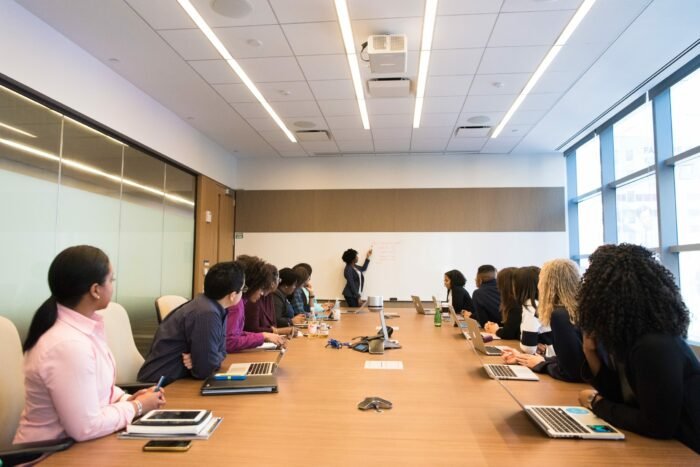Change is an inevitable part of any organization’s journey towards growth and success. However, managing change can be a complex and challenging process. That’s where change management models come into play. These models provide businesses with frameworks, strategies, and techniques to effectively navigate organizational change and ensure a smoother transition.
Change management models are designed to guide businesses through each stage of the change management process. They help organizations analyze their current processes, determine the need for change, develop an effective change management strategy, implement the necessary changes, and continually monitor and evaluate the outcomes. By following these models, businesses can maximize the benefits of change while minimizing the disruptions and resistance that often accompany it.
There are various change management models available, each with its own unique approach and focus. Some popular models include Lewin’s Change Management Model, the McKinsey 7-S Model, Nudge Theory, the ADKAR Change Management Model, and the Kübler-Ross Change Curve. These models have proven to be effective in different contexts and have been widely adopted by organizations across various industries.
In this article, we will explore these popular change management models in detail and highlight their key features and benefits. By understanding and applying these models, businesses can identify the most effective strategies and techniques for managing change in their specific contexts.
Throughout the article, we will discuss change management strategies, principles, tools, and techniques that can contribute to the effective implementation of change management models. We will also explore organizational change best practices and successful change management models used by industry leaders.
Join me as we delve into the world of change management models and discover how they can help organizations navigate the complexities of organizational change and drive success in today’s ever-changing business landscape.
Key Takeaways:
- Change management models provide frameworks, strategies, and techniques for effectively managing organizational change.
- Popular change management models include Lewin’s Change Management Model, the McKinsey 7-S Model, Nudge Theory, the ADKAR Change Management Model, and the Kübler-Ross Change Curve.
- Understanding and applying these models can help businesses analyze current processes, implement effective changes, and maximize the benefits of organizational change.
- Change management best practices and successful change management models will be explored throughout the article.
- By selecting the most suitable change management model for their specific needs, organizations can adapt, grow, and thrive in today’s dynamic business environment.
Lewin’s Change Management Model
In the realm of change management, one model that has stood the test of time is Lewin’s Change Management Model. Developed by Kurt Lewin, this model offers a structured approach to navigate the complexities of organizational change. By breaking down the change process into three distinct stages, businesses can effectively manage the transition and ensure long-term success.
The Three Stages of Lewin’s Change Management Model:
- 1. Unfreeze: The initial stage involves creating awareness of the need for change and preparing employees for the impending transition. This stage involves challenging existing mindsets, breaking down resistance, and fostering an environment conducive to change.
- 2. Change: Once the organization is unfrozen, this stage focuses on implementing the desired changes. It involves defining new processes, introducing improvements, and guiding employees through the transformational journey. Communication and training play a crucial role in ensuring a smooth transition.
- 3. Refreeze: In the final stage, the new changes are solidified as the new norm. The organization establishes systems, processes, and mechanisms to sustain the changes and ensure their integration into the organizational culture. Ongoing evaluation and reinforcement help maintain the change and create a sense of stability.
Lewin’s Change Management Model provides a roadmap for businesses to analyze current processes, introduce improvements, and guide employees through the transition. By understanding and applying this model, organizations can effectively navigate change and maximize the positive impact it has on their operations and culture.
“Change is the only constant in life.”
– Heraclitus
| Pros | Cons |
|---|---|
| Clear and logical framework | May not account for all complexities of change |
| Emphasizes the importance of employee buy-in | Does not address simultaneous changes in multiple areas |
| Easy to understand and implement | Relies on a top-down approach |
| Provides structure and guidance throughout the change process | May not consider individual emotional reactions to change |
McKinsey 7-S Model
The McKinsey 7-S Model is a comprehensive change management framework that considers seven crucial elements for successful change implementation. These elements include Strategy, Structure, Systems, Shared Values, Style, Staff, and Skills. By analyzing and aligning these interdependent factors, businesses can navigate and drive transformation effectively.
The Strategy component focuses on defining the organization’s long-term objectives, goals, and plans for change. It involves identifying key initiatives, market positioning, and competitive advantages to guide the transformation process.
The Structure element examines the organization’s existing hierarchy, reporting lines, and divisions. It aims to ensure that the structure supports the desired change outcomes and facilitates communication, collaboration, and decision-making within the organization.
The Systems aspect refers to the processes, procedures, and technologies that support daily operations. It assesses if the current systems can accommodate the proposed changes and identifies areas that require improvement or realignment.
The Shared Values component comprises the organization’s core beliefs, vision, and culture. It emphasizes the importance of aligning the change efforts with the organization’s values to foster a sense of purpose and commitment among employees.
The Style element evaluates the leadership and management styles within the organization. It examines how leaders motivate and guide employees through the change process, inspiring trust, open communication, and collaboration.
The Staff factor focuses on the organization’s workforce, their skills, capabilities, and capacity to adapt to change. It involves assessing if the current workforce possesses the necessary skills and knowledge to support the change and identifying any gaps that need to be addressed.
The Skills component pertains to the specific abilities and expertise required to execute the change successfully. It involves evaluating the organization’s capabilities, training needs, and potential external partnerships or hires to ensure the availability of the necessary skills.
By addressing each of these elements and analyzing their interdependencies, the McKinsey 7-S Model enables businesses to identify areas of improvement, create targeted change strategies, and foster an environment that supports successful change implementation.
Benefits of the McKinsey 7-S Model
The McKinsey 7-S Model provides a holistic approach to change management, considering various critical aspects that influence the organization’s ability to adapt and thrive. By analyzing the seven elements and aligning them effectively, businesses can:
- Identify and address potential barriers to change
- Ensure consistency and alignment across the organization
- Facilitate effective decision-making and communication
- Foster a positive and supportive organizational culture
- Maximize the utilization of available resources
Nudge Theory
In the realm of change management, Nudge Theory offers a unique and effective approach to guiding employees towards desired changes. Unlike traditional enforcement methods, Nudge Theory recognizes the power of subtle, indirect suggestions and evidence-based strategies in influencing behavior. By understanding the principles of Nudge Theory and implementing its strategies, businesses can encourage employees to embrace change and actively participate in the transition process.
At its core, Nudge Theory revolves around the idea that small nudges can create significant shifts in behavior. These nudges are designed to gently guide individuals towards making choices that align with the desired change. Rather than imposing change forcefully, Nudge Theory aims to influence decision-making processes and gently steer employees towards the desired outcome.
The success of Nudge Theory lies in its ability to leverage human psychology and cognitive biases. By framing change as a choice, presenting compelling evidence, and considering employee perspectives, businesses can increase employee buy-in and motivation. This approach taps into the innate human desire for autonomy and ownership, empowering employees to see the benefits of change and actively participate in the organizational transition.
The power of Nudge Theory lies in its ability to influence behavior by subtly shaping the context in which decisions are made.
When applying Nudge Theory, businesses should consider the following key principles:
- Clearly define the changes: Communicate the specifics of the desired change to ensure employees have a clear understanding of what is expected.
- Consider employee perspectives: Assess the potential impact of the change on employees and involve them in the decision-making process to enhance their sense of ownership.
- Provide evidence: Back up the need for change with relevant data and examples to increase employees’ confidence in the proposed changes.
- Present change as a choice: Frame the change as an opportunity for growth and improvement, emphasizing the positive outcomes that can be achieved.
- Listen to employee feedback: Actively solicit and consider employee feedback throughout the change process to ensure their voices are heard and their concerns are addressed.
| Nudge Theory | Benefits |
|---|---|
| Encourages employee autonomy | Increases employee engagement |
| Respects individual decision-making processes | Reduces resistance to change |
| Utilizes evidence-based strategies | Facilitates smoother transitions |
The ADKAR Change Management Model
The ADKAR Change Management Model, developed by Jeffrey Hiatt, provides a comprehensive framework for managing change within organizations. This model focuses on the people aspect of change, recognizing that successful change initiatives require employee engagement and involvement.
The ADKAR model consists of five key goals that guide the change management process:
- Awareness: Creating an understanding among employees about the need for change and the reasons behind it.
- Desire: Cultivating a desire within employees to participate and support the change, emphasizing the benefits and addressing any concerns or resistance.
- Knowledge: Equipping employees with the necessary knowledge and skills to implement the change effectively, providing training and resources as needed.
- Ability: Ensuring that employees have the ability to apply their knowledge and skills in practice, providing support and guidance throughout the transition.
- Reinforcement: Sustaining the change by reinforcing new behaviors and practices, recognizing and rewarding employees for their efforts, and continuously monitoring progress.
By addressing each of these goals, organizations can navigate change more effectively and increase the chances of successful implementation. The ADKAR model emphasizes the importance of clear communication, employee involvement, and ongoing support throughout the change process.
Implementing the ADKAR model requires a systematic approach, involving thorough planning, stakeholder engagement, and a focus on individual and organizational readiness for change. By following the ADKAR framework, businesses can minimize resistance, maximize employee adoption, and achieve desired outcomes during times of change.
Key Benefits of the ADKAR Change Management Model:
- Focuses on the people aspect of change, recognizing the importance of employee engagement and involvement.
- Provides a clear and systematic approach to managing change, ensuring all essential elements are addressed.
- Emphasizes the importance of effective communication and transparency throughout the change process.
- Helps identify and address individual barriers to change, increasing employee buy-in and support.
- Ensures employees have the necessary knowledge, skills, and support to adapt to and sustain the change.
- Promotes a positive and supportive change culture within the organization.
By utilizing the ADKAR Change Management Model, organizations can navigate change successfully, minimize disruption, and achieve long-term sustainability in a rapidly evolving business landscape.
Kübler-Ross Change Curve
The Kübler-Ross Change Curve, derived from the five stages of grief, provides valuable insights into the emotional journey individuals undergo during times of change. These stages include Denial, Anger, Bargaining, Depression, and Acceptance. Each stage represents a different emotional response and adjustment process that individuals may experience when confronted with change.
Understanding and addressing the Kübler-Ross Change Curve can be instrumental in navigating employee reactions to change within a business setting. By recognizing and empathizing with these emotional stages, organizations can anticipate and respond to the various needs and concerns of their employees.
When businesses encounter change, it is important to provide support and guidance to employees as they progress through the Kübler-Ross Change Curve. By acknowledging the emotions associated with each stage and creating a supportive environment, businesses can help ease the transition and ultimately foster acceptance of the change.
Addressing the Kübler-Ross Change Curve
- Denial: Many individuals initially respond to change with a sense of denial, refusing to accept the reality of the situation. Acknowledging this stage involves providing clear communication and factual information to help employees grasp the need for change.
- Anger: As individuals move out of denial, they may experience anger and frustration. Validating these emotions and providing outlets for employees to express their concerns can contribute to a healthier transition process.
- Bargaining: In this stage, individuals may seek ways to negotiate or minimize the impact of the change. Organizations can address this stage by enabling open dialogue, allowing employees to participate in decision-making processes where appropriate.
- Depression: As the reality of the change sets in, individuals may experience feelings of sadness and loss. Providing emotional support and resources, such as counseling or access to employee assistance programs, can assist employees in navigating this stage.
- Acceptance: The final stage of the Kübler-Ross Change Curve involves embracing and integrating the change. By recognizing and celebrating the positive outcomes of the change, businesses can solidify acceptance and facilitate a smoother transition for their employees.
Table: Comparing the Kübler-Ross Change Curve with Other Change Management Models
| Change Management Model | Focus | Key Characteristics |
|---|---|---|
| Kübler-Ross Change Curve | Emotional journey during change | Recognizes and addresses the emotional stages individuals undergo during change |
| Lewin’s Change Management Model | Overall change process | Unfreeze, Change, Refreeze stages; emphasizes preparation, implementation, and solidification of change |
| McKinsey 7-S Model | Alignment of key organizational elements during change | Strategy, Structure, Systems, Shared Values, Style, Staff, Skills; emphasizes alignment and balance of these elements |
| Nudge Theory | Indirect methods of guiding change | Subtle suggestions and evidence-based strategies to gently guide employees towards change |
| ADKAR Change Management Model | People-centric change approach | Awareness, Desire, Knowledge, Ability, Reinforcement; emphasizes the importance of employee engagement and involvement |
Conclusion
Change management models are invaluable for organizations navigating the complexities of organizational change. In this article, we have explored several popular and successful change management models, including Lewin’s Change Management Model, the McKinsey 7-S Model, Nudge Theory, the ADKAR Change Management Model, and the Kübler-Ross Change Curve. These models provide frameworks, strategies, and techniques that organizations can leverage to effectively implement and manage change.
By understanding and applying these models, businesses can increase the likelihood of successful change initiatives and create a positive organizational environment. These models help organizations achieve desired outcomes by providing a clear roadmap for navigating the challenges that come with change. It is crucial for organizations to carefully select the change management model or models that align best with their specific needs and goals.
With the right change management model in place, businesses can adapt to new challenges, drive growth, and thrive in today’s ever-changing business landscape. Effective change management is a critical aspect of organizational success, and the utilization of these popular change management models can drastically increase the effectiveness of change initiatives. By embracing change and implementing proven models, organizations can pave the way for a successful future.
FAQ
What are change management models?
Change management models are frameworks, strategies, and techniques that guide businesses in implementing and managing organizational change effectively.
Why are change management models important?
Change management models are essential for successfully navigating organizational change. They provide a structured approach and help businesses maximize the benefits of change.
What is Lewin’s Change Management Model?
Lewin’s Change Management Model is a popular model that breaks down the change process into three stages: Unfreeze, Change, and Refreeze. It emphasizes the importance of preparing for change, implementing the change, and solidifying the new changes as the new norm.
What is the McKinsey 7-S Model?
The McKinsey 7-S Model is a comprehensive change management model that focuses on seven key elements: Strategy, Structure, Systems, Shared Values, Style, Staff, and Skills. It recognizes the interconnectedness of these elements and emphasizes the need to align them for successful change.
What is Nudge Theory?
Nudge Theory is a change management approach that relies on gentle suggestions and evidence-based strategies to guide employees towards desired changes. It emphasizes providing choices, considering employee perspectives, and encouraging active participation.
What is the ADKAR Change Management Model?
The ADKAR Change Management Model focuses on the people aspect of change. It outlines five key goals: Awareness, Desire, Knowledge, Ability, and Reinforcement. This model emphasizes the importance of employee engagement and involvement.
What is the Kübler-Ross Change Curve?
The Kübler-Ross Change Curve is based on the five stages of grief and acknowledges the emotional reactions that often accompany change. By understanding and addressing these emotional stages, businesses can facilitate a smoother transition and increase acceptance of change.










![How to Improve Employee Welfare? [7 Ways] 11 How to Improve Employee Welfare](https://zoets.b-cdn.net/wp-content/uploads/2024/02/pexels-alexander-suhorucov-6457577-scaled-e1708707251724.jpg)
![Saudi Oil Industry Key Stats Unveiled [2024] 12 Saudi Oil Industry Key Stats](https://zoets.b-cdn.net/wp-content/uploads/2024/02/h.jpg)